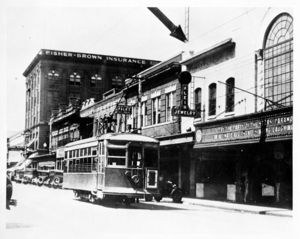Difference between revisions of "Pensacola streetcar system"
(will add more later) |
|||
| Line 1: | Line 1: | ||
[[Image:PensacolaTrolley.jpg|thumb|A trolley travels south on [[Palafox Street]], circa 1920s]] | [[Image:PensacolaTrolley.jpg|thumb|A trolley travels south on [[Palafox Street]], circa 1920s]] | ||
| − | The '''Pensacola streetcar (trolley) system''' was operated by the [[Pensacola | + | The '''Pensacola streetcar (trolley) system''' was a public transportation system that was operated by various entities between [[1884]] and [[1932]]. |
| + | |||
| + | The streetcar system in Pensacola can be traced to [[Conrad Kupfrian]], a German immigrant who was reportedly inspired by the horsecars he saw in St. Louis on a business trip. He formed a partnership, the [[Pensacola Streetcar Company]], with [[John Pfeiffer]] and [[John Cosgrove]]. The men raised $50,000 in capital for the project and, on [[November 15]], [[1882]], convinced the [[Pensacola City Council]] to pass an ordinance allowing steel track to be placed in the roadways. The first streetcars, which went operational in [[1884]], ran from [[Pensacola Bay]] north along [[Palafox Street]] to [[Wright Street]], then east to the [[Union Depot]], then south along [[Alcaniz Street|Alcaniz]] to [[Gregory Street|Gregory]] and west to [[DeVilliers Street]]. A north-south link at DeVilliers went south to [[Government Street]] and east again to Palafox. A general fare cost five cents, and cars passed about every ten minutes during high-traffic periods. The company addressed the issue of low ridership after business hours by creating an amusement park destination, called [[Kupfrian's Park]], in the [[North Hill]] neighborhood. | ||
| + | |||
| + | At its peak, a total of 30 trolley cars carried four million passengers per year (1920).<ref>[http://www.dot.state.fl.us/publicinformationoffice/historicdotphotos/rail/pentrolley.htm MyFlorida.com]</ref> Routes included a line in [[Gadsden Street]] [crossing the old [[Bayou Texar]] Bridge to East Pensacola Heights] and a line to [[Kupfrian's Park]]. Also included was a loop encompassing Palafox Street, West Gadsden Street, North Spring Street, and West DeSoto Street back to Palafox, with a turnaround spur reaching on Gadsden past Spring to North [[Reus Street]]. Partially covered tracks and barely concealed right-of way are clearly visible on Gadsden [especially the turnaround track] and DeSoto Street. Another loop reached Old [[East Hill]] via [[Government Street]] to [[Alcaniz Street]] and back to Gadsden. The trolley was discontinued six years after Pensacola Electric Company's [[1932]] merger with [[Gulf Power]]. | ||
==Other images== | ==Other images== | ||
Revision as of 02:51, 19 June 2008

The Pensacola streetcar (trolley) system was a public transportation system that was operated by various entities between 1884 and 1932.
The streetcar system in Pensacola can be traced to Conrad Kupfrian, a German immigrant who was reportedly inspired by the horsecars he saw in St. Louis on a business trip. He formed a partnership, the Pensacola Streetcar Company, with John Pfeiffer and John Cosgrove. The men raised $50,000 in capital for the project and, on November 15, 1882, convinced the Pensacola City Council to pass an ordinance allowing steel track to be placed in the roadways. The first streetcars, which went operational in 1884, ran from Pensacola Bay north along Palafox Street to Wright Street, then east to the Union Depot, then south along Alcaniz to Gregory and west to DeVilliers Street. A north-south link at DeVilliers went south to Government Street and east again to Palafox. A general fare cost five cents, and cars passed about every ten minutes during high-traffic periods. The company addressed the issue of low ridership after business hours by creating an amusement park destination, called Kupfrian's Park, in the North Hill neighborhood.
At its peak, a total of 30 trolley cars carried four million passengers per year (1920).[1] Routes included a line in Gadsden Street [crossing the old Bayou Texar Bridge to East Pensacola Heights] and a line to Kupfrian's Park. Also included was a loop encompassing Palafox Street, West Gadsden Street, North Spring Street, and West DeSoto Street back to Palafox, with a turnaround spur reaching on Gadsden past Spring to North Reus Street. Partially covered tracks and barely concealed right-of way are clearly visible on Gadsden [especially the turnaround track] and DeSoto Street. Another loop reached Old East Hill via Government Street to Alcaniz Street and back to Gadsden. The trolley was discontinued six years after Pensacola Electric Company's 1932 merger with Gulf Power.
Other images
South Palafox Street, early 1900s
Bayshore line car, circa 1930
South Palafox Street near Plaza Ferdinand VII





